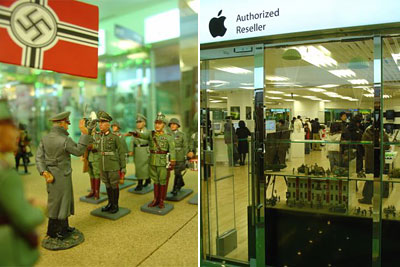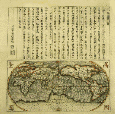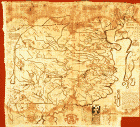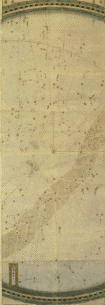




Franky Goes To HollywoodならぬVatican City, officially State of the Vatican City (Latin: Status Civitatis Vaticanae; Italian: Stato della Città del Vaticano)と支那共産党が手打。16世紀からの付き合いでっからな。。イタ公エロ坊主と欲ボケチャンコロ共産党がねーW.
チョッパリもスケールが小さいな。アーパーマンションで安晋会と思いきや、B系ケケ中がダボス会議ってか?チョッパリヘルスデージンの柳澤はん!出産機械は拙いでっせ。本音なんだろうが;。
天ちゃんを召集するんではなく、天ちゃんが召集するんでっせ中川(女)ハンWW。不敬罪なりマッセ。
チョンボ。チョンボ。錯和狆和W.満貫払いデンナ。
「蛾の成虫入りアンパンマンチョコレート」は食べても無害 by 不二家だがアーパーマンションは地震で死ぬってか?帽子のオバハン。WW
放射能"hot" teapotならイタ公は浴びてないはずだが?MI6はん。ポロニウムって@線オンリー。
南鮮チョンコロがユダヤに喧嘩売ってる?ナチ賛美は拙いでしょ。by撃墜王ゲーリング元帥&ロンメル将軍。地政学的には似たモン同士だからか??
A Wider World, II
How Rome Went to China
By the later sixteenth century, the horizons of Rome's intellectuals had widened enormously. They now included not only Rome, Greece, and Egypt but a Far Eastern culture that westerners had hardly known since the days of Marco Polo, long before -- China.From the 1540s, Jesuit missionaries in East Asia tried to convert the Chinese and Japanese to Christianity, as part of the Counter-Reformation drive to win the world back to Rome. The Japanese mission failed quickly, but the Chinese one seemed immensely promising. Jesuits like Matteo Ricci learned Chinese, mastered the canon of classic Confucian texts, dressed as mandarins, and joined the imperial court. They showed the Chinese intellectuals that the west had superior skills in some areas that the Chinese recognized as vital, like cartography and astronomy, and they translated accounts of western ideas and Christian doctrine into Chinese for their converts. For a time their mission prospered.
Meanwhile the Vatican, which controlled and managed the missionary enterprise, became a great repository both of the works the Jesuits produced in Eastern languages and of texts and works of art that they sent back. By the middle of the seventeenth century, the famous Roman Jesuit Athanasius Kircher could try to study Chinese in Rome. He insisted that the Chinese tradition was as old and profound as that of the Egyptians (indeed, he saw Chinese ideograms and Egyptian hieroglyphs as deriving from the same roots). Some argued that Chinese culture was actually more moral and pious than European.
Like earlier humanist efforts to find pagan sages who could teach Christians basic truths, the Jesuits' Chinese enterprise, too, eventually failed. But the Vatican's holdings wonderfully exemplify the fragile, fascinating bridge of texts and images which the Jesuits built in order to reach, understand--and convert--the most foreign of cultures.
- Giulio Aleni, Wan-kuo ch`uan-t`u (Complete map of all nations)
Matteo Ricci, the first Jesuit missionary to become adept in Chinese, produced a map of the world, on Western principles, in Chinese. The Ricci map went through several versions from 1574 to 1603 and profoundly influenced western cartography. Although East Asia--and China in particular--is represented clearly and with scientific precision, nevertheless several of China's own cartographers, writing independently of the court, criticized the configuration as an insult to China's centrality. Sometime in the 1620s Giulio Aleni had this abridgment of Ricci's map printed and hand-tinted. Aleni's name is in the left-most column of Chinese on the upper half, above the Jesuit seal.
Barb. or. 151, fasc. 1a china01 HG.03
- Giulio Aleni, K`un-yu t`u-shuo
Giulio Aleni, the equally skilled and effective successor to Matteo Ricci in China, supervised this wood-block printing of a book on the wonders of the western world, titled literally "An Illustrated Explanation of Geography." Here we see the Colossus of Rhodes, guarding that Mediterranean harbor, an image quite familiar to westerners from both classic and popular archaeology. The Chinese book shown here does not represent the best of Chinese wood-block engraving but appears to be a cheap printing (there is no publishing information given). It was probably sponsored by one of the churches that Aleni fostered in Fukien, where low-cost and quick printing abounded.
Borg. cin. 350, fasc. 30 fols. 75-76 china02 HG.09
- Michael Boym, Maps of Great Cathay
The Jesuit Michael Boym based his album of eight maps of China on his own experience of the country and on Chinese gazetteers. The opening page of his impressive album features the entire East Asian subcontinent. Although it does not depict the Korean- Japanese configuration with scientific accuracy, it does give details of China's river and mountain systems. According to a Vatican colophon, the work was purchased in 1729 by someone named Riamonteger and was later deposited in the Borgia collection.
Borg. cin. 531 general map HG.11
- Letter of appreciation to the Church
 In Japanese, with Latin translation, 1621
In Japanese, with Latin translation, 1621 This letter was written in 1621 by Japanese officials who identify themselves as being from Gokinai, a word that referred to five imperially controlled districts around the capital at Edo, near Tokyo. Such officially attached lands were traditional bureaucratic institutions, not natural market or temple towns. Thus the signers would have been speaking as functionaries, not as residents of a town. They offer praise to the Catholic religion. A Latin translation is given on the same sheet.
Barb. or. 152, fasc. 3 china04
- Adam Schall von Bell, Eight-part cosmological map
Adam Schall was the first European ever to have been a member of the court bureaucracy in Peking. As part of his duties as head of the Office of Astronomy, he produced this large and truly spectacular six-part cosmological map, accompanied by pictures of astronomical instruments.
NOTE:This is only one part of the map. For the complete view you can go the the Map Room.
Barb. or. 149 china05 HG.07
- Abraham Ortelius, Asiae Orbis partium maximae nova descriptio
Venice: Donatus Bertelli, 1567
Abraham Ortelius's "New Map of Asia," of which a detail is shown here, was printed in 1567 on two flat sheets and shows the state of European knowledge of Asia before the Jesuit mission. Ortelius included traditional terms and images drawn from Marco Polo and other old sources, Tartar and Scythian place-names, renditions of the desert tents of Mongolian Great Khans, and the locations of Inner Asian states, such as Tibet and Tangut, that fought the Mongols in the thirteenth and fourteenth centuries. Much of north Asia is left blank, and there is no Korea. Two names are used at once for China: "Cataio" (central and central- western China) and "China" (the south). Quinsai and Zaiton, richly described by Polo, are displaced to the north. Ortelius places a pair of lions in the Chinese heartland, but his map lacks the corresponding lavish flora and fauna evident in Michael Boym's later work.
Stamp. geogr. I 9 china06 HG.17
VATICAN - CHINA
The Pope prepares a letter to China’s Catholics
The announcement was made at the end of a 2 day meeting in the Vatican. The Holy See reaffirms its desire to continue a “constructive and respectful dialogue” with the Beijing Government, arriving at full diplomatic relations.

Vatican City (AsiaNews) – Benedict XVI has decided to shortly “address a letter to the Catholics of China”: this was the important conclusion contained in an official statement released by the Holy See press office at the end of a 2 day meeting held at the Vatican January 19 and 20. Participating in the meeting which had as its theme “The situation of the Catholic Church in China” were Chinese bishops from Hong Kong, Macao and Taiwan and the most important representatives from the Secretary of State and the Congregation for the Evangelization of Peoples. The meeting was presided over by Cardinal Tarcisio Bertone, secretary of state. The statement affirms that “The will to continue on the journey of a respectful and constructive dialogue with the governing authorities in order to overcome past difficulties, emerged. More over, the hope was expressed that a normalization of relations on all levels would come to pass”.
The statement notes that the meeting was called at the express wish of the Pope “in the desire to deepen his knowledge of the situation of the Catholic Church in China”.
The meeting “was animated by a frank and fraternal cordiality” and examined “the most serious and urgent ecclesial problems, which call for adequate solutions based on the fundamental principles of the Church’s divine constitution and religious freedom”. In the last few months in China there have been a series of arrests of priests loyal to the underground Church as well as the ordination of priest without the approval of the Holy See, facts judged by the Vatican to be “a grave violation of religious freedom”.
The statement highlights the “troubled history of the Church in China” and recalls the heroism of many faithful, priests and bishops of the underground church who have suffered persecution: “The Church expresses its profound gratitude for the inspiring witness of the bishops priests and lay faithful, who without compromise, have maintained their loyalty to the see of peter, often paying a grave and painful price by doing so.”
According to AsiaNews data at least 17 underground bishops have disappeared, been arrested or are detained in isolation; 20 priests have been arrested. The latest arrest took place on December 27th in Hebei. Of the 9 priests arrested, 5 remain in prison, 4 have been released.
At the same time the statement highlights that the official Church (“almost in it’s totality”) is in communion with the Pope. “The Church notes with particular joy that almost all of the bishops and priests are in communion with the Holy Father”. At least 85% of the bishops from the official Church – registered and recognised by the government – have been for years now in contact with the Holy See, contrasting the work of the Patriotic Association bent on creating a Church independent of Rome.
The statement continues “The numeric growth of the ecclesial community in china is further more surprising, where it is called to be a witness to Christ, to look ahead in hope and to measure itself against the new challenges that society is facing”.
Data from the Holy Spirit Study Centre in Hong Kong show that there are 12 million Catholics presently in China. In ‘49, before the coming to power of Mao Zedong, there were 3 million. According to AsiaNews sources, in China each year there are over 150 thousand newly baptised most of whom are adults. The important factor is that many of them come from the cultural spheres of the cities, universities and business world.
“In the multiplicity of the participant’s contribution - the statement reads - the will to continue on the journey of a respectful and constructive dialogue with the governing authorities in order to overcome past difficulties, emerged. More over, the hope was expressed that a normalization of relations on all levels would come to pass in order to allow a peaceful and fruitful life of faith in the Church and to work together for the good of the people of China and peace in the world”.
It is no secret that the Chinese Government for some time now has been sending positive signals to up a dialogue with the Vatican, above all to present to the world in occasion of the Olympics “a great nation” modern and free. However it has to take into account the hard fringe elements of the Party – and the Patriotic Association – that are against the re-establishment of diplomatic relations. China and religious freedom have been ever present on the agenda of Benedict XVI, since the very beginning of his pontificate.
The statement concludes saying that “The Holy Father was fully informed of the proposals reached in the course of the meeting” and “has benevolently decided to address a letter to the Catholics in China”. It’s probable that more specific questions such as the unity of the Church (official and non), how to deal with illicit ordinations and how to deal with the Patriotic Association, will be directly dealt with by the Pope.
Some within the Church feel that the Vatican should not open up to diplomatic relations with Beijing until the Church does not enjoy full religious freedom, free from AP oppression. Others suggest to open relations with China and slowly annul the negative influence of the Association. In fact because of this difference of opinion many Chinese Bishops had asked for the Pope to address the issue in a letter on many occasions. (BC)


安晋会というのはケケ中人脈である。杉山敏隆という人は、同時期に「竹中平蔵経済塾」を発足させてるわけでね。売国奴 ケケ中にぶらさがった三流経済人たちが、次期首相と目されていたアベッチに媚を売るために作った組織である。アーパーマンションでっか?風評被害でアパマンの株が値下がりしたりしてるんだが、そこら辺について、日本アンチキムチ団さんときち@石根さんとこで謎解きしてます。
ついに明らかにされた、竹中平蔵の少年時代の秘密
http://amesei.exblog.jp/1708133/
アメリカからの「派遣大臣」の竹中氏が、日本の派遣業界大手の特別顧問というのは、何ともぞっとしない話である。竹中氏は大臣時代に、正社員である先輩議員を差し置いて「小泉改革」の先頭に立ってきたわけで、その竹中氏が派遣業界の顧問に就任とは、冗談のような話だ。
「父親は小さな履物小売商をやっていた普通の商売人なんですが、父を見てると、世の中が不公平に見えるわけですね。父親はこれだけ苦労をして一所懸命働い てるのに金持ちになれない。もっと楽してお金儲けしている連中が一杯いるのに・・・・。どうやったらもっと住みやすい、よい世の中になるんだろう」(中 略)
同級生から「緻密で冷静」と評されていた竹中が別の側面を見せたのは、六七年十一月、和歌山市で「第四回全国高校生部落問題研究会」 が開かれた時のことだった。十七都府県二百三十二校から二千三百名が結集した会場に高校二年生の竹中も足を運び、各分科会を精力的に回り、発言していたと いう。(中略)
周囲が驚いたのは、その集会で、和歌山のある集落の出身者がひどい就職差別を受けたという報告があったときのこと。竹中の顔が怒りでみるみる真っ赤になったのである。
で、今回問題が発覚したのもブラブラ職員が蔓延る京都。
斎藤貴男氏の「不平等社会日本」(文春文庫)によれば、東大法学
部のネットワークから外れてしまった人間である。その大学受験の
時期が、ちょうど大学紛争で東大入試が中止された時期に重なって
いたので、仕方なく、一橋大学に入ったのである。更にいえば、
竹中平蔵こそ、和歌山の靴屋(要するに部落民)出身で、東大に入
れなかったルサンチマンから米国にすり寄って、出世したアメリカ
の手先そのものであるという危ない見方すらできるだろう。別に
これは断じて部落差別を容認している訳ではなく、既存のネットワ
ークから拒絶された人間は、また新しくネットワークを作らざるを
得ないという法則の話をしているだけである。誤解されないように。
天皇陛下を忘れていた中川(女)
中川秀直自民党幹事長が大チョンボをしたそうで。なんと、天皇陛下をすっかり忘れて、勝手に国 会を召集してしまったという非国民ぶり。さすがはヤクザや愛人とうつつを抜かすロクデナシだ。本来なら国会というのは「天皇陛下が国会議員を召集」して開 かれるものなのに、今回に限っては「ヤクザ幹事長が国会議員を召集」して25日に開催し、翌26日に「天皇陛下を呼びつけて挨拶させる」という不敬の極み になってしまった。語源
錯和の語源は明代まで遡る。勘合貿易において、倭人(和人)を偽って密貿易を行おうとする輩が続出し、錯和の語が現れた。(琉球の歴史書『中山世譜』)
Murdered spy Litvinenko was killed with radioactive teapot
Xeni Jardin: Snip from ABC News: Link (thanks, violet blue!)British officials say police have cracked the murder-by-poison case of former spy Alexander Litvinenko, including the discovery of a "hot" teapot at London's Millennium Hotel with an off-the-charts reading for Polonium-210, the radioactive material used in the killing.
A senior official tells ABC News the "hot" teapot remained in use at the hotel for several weeks after Litvinenko's death before being tested in the second week of December. The official said investigators were embarrassed at the oversight.
The official says investigators have concluded, based on forensic evidence and intelligence reports, that the murder was a "state-sponsored" assassination orchestrated by Russian security services.
Whups: Nazi toy soldiers in Seoul Apple retailer's display
Xeni Jardin: 
Alec Porter says,
I was stunned to see these handpainted Nazi toy soldiers on display in the Apple store in Korea's biggeset mall, in Seoul. It's not an official Apple Store, but it's certainly Apple's representative in Korea; everyone who shops for Apple considers that the place.Korea is not know for being sensitive about the Holocaust or Nazi Germany. Perhaps they'd say the same about the west and how we're not very sensitive about Japanese Imperialism, and the horrors it inflicted on Asia. Still, this is pretty shocking.
イスラエルという国と韓国という国が、東西対立の地政学的な役割においてよく似通っている、と書いているのは阿修羅という掲示板への投稿なんだが、
両 国は周辺国と異なる言語と文字を用い、民族としては非常に長い歴史を持つが、真の独立国家となったのは共に第二次大戦後であり、米国の軍事同盟国で地政学 的要地に位置する小国であり巨大な陸軍力を持つ。更に、イスラエルと韓国はそれぞれドイツと日本に痛めつけられた可哀想な被害者として全世界にドイツと日 本の蛮行を宣伝し続けるという役割を果たしていた。そして、一九八九年の前にはドイツは米国とソ連の、日本は米国と中ソの軍事的対立の最前線に位置させら れ、戦争勃発時には国土が戦場となるという恐怖に脅迫されていた。と、こう説明されると納得してしまうものがあるんだけどね。そもそも第二次世界大戦というのが、急成長していた日本とドイツを押さえつけるためにユダヤ金融資本が起こした戦争なんだが、終戦後はその両国への「重し」としてイスラエルと韓国が利用されてきたわけだ。
Direct link to HQ version: here
Japan's health minister: Women are "birth-giving machines"
Cory Doctorow: Japan's 71-year-old health minister Hakuo Yanagisawa gave a speech in which he called Japanese women "birth-giving machines" and called on them to "do their best per head." The number of women aged between 15 and 50 is fixed. Because the number of birth-giving machines and devices is fixed, all we can ask for is for them to do their best per head, although it may not be so appropriate to call them machines.










0 件のコメント:
コメントを投稿